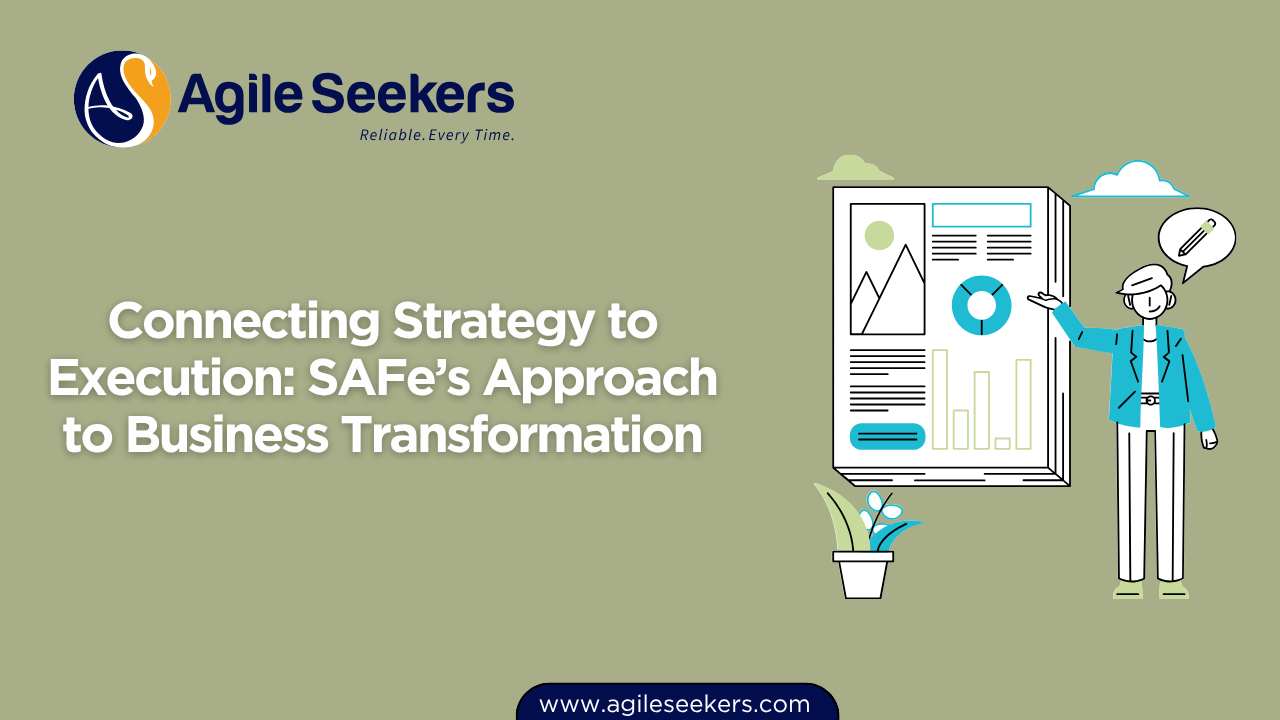Connecting Strategy to Execution: SAFe’s Approach to Business Transformation

Business transformation is no longer just about digitization or cost-cutting. It’s about realigning the entire organization around value delivery. The Scaled Agile Framework® (SAFe®) provides a proven approach to bridge the gap between strategic vision and hands-on execution, helping enterprises deliver outcomes that matter—at speed and scale.
This post explores how SAFe connects high-level business strategy to on-the-ground execution, and how organizations can use it to drive measurable transformation.
Why Strategy Often Fails Without Execution Alignment
Strategic planning fails when there’s a disconnect between executives who define the strategy and the teams tasked with delivering it. This gap widens as organizations grow in complexity—multiple departments, conflicting priorities, and unclear value streams can derail transformation efforts.
SAFe addresses this issue by structuring the organization around value streams and using the Lean-Agile mindset to keep everyone aligned. It doesn’t just stop at planning—SAFe integrates delivery, feedback loops, and governance across all levels of the enterprise.
Translating Vision into Objectives Using SAFe
At the top level, SAFe starts with a clear Strategic Theme—concise statements that guide the portfolio’s direction. These themes influence Portfolio Backlogs, which feed into the Value Streams and eventually into the Agile Release Trains (ARTs) responsible for delivery.
Key Enablers in this translation:
-
Portfolio Vision & Strategic Themes: Executive leaders define these themes to align development with business goals.
-
Portfolio Kanban System: Helps prioritize Epics, ensuring only the most valuable work gets funding and attention.
-
Epic Owners and Enterprise Architects: Drive the exploration and governance of these large initiatives.
To understand how this works at scale, consider enrolling in the Leading SAFe Certification, which gives a solid foundation in how SAFe connects portfolio-level decisions to Agile teams.
Aligning Value Streams to Strategy
SAFe structures work around Value Streams, which are the sequence of activities needed to deliver value to the customer. Each value stream is served by one or more ARTs—long-lived teams that deliver incremental value every 8–12 weeks.
Why this matters:
-
Teams stop working in silos and start collaborating toward shared business outcomes.
-
Dependencies are managed better since everyone is aligned to the same delivery pipeline.
-
Funding shifts from projects to value streams, enabling flexibility and faster decision-making.
This level of alignment is central to business agility and is covered in depth during SAFe Release Train Engineer (RTE) training, where facilitators learn how to steer ARTs toward strategic objectives.
PI Planning: The Execution Engine of SAFe
At the team-of-teams level, SAFe connects execution to strategy through Program Increment (PI) Planning. This two-day event brings together all teams in the ART to plan, align, and commit to objectives for the next increment.
What happens during PI Planning:
-
Teams break down features into stories.
-
They identify cross-team dependencies.
-
They commit to shared objectives based on business priorities.
The outcome is a set of team and program-level objectives directly linked to strategic goals. Teams stay focused on what matters, and stakeholders get visibility into progress.
Scrum Masters play a vital role here by removing impediments and supporting facilitation. The SAFe Scrum Master certification equips professionals with the tools to support ARTs during this critical alignment activity.
Role of Product Management in Strategic Alignment
Product Management acts as the bridge between customer needs and delivery execution. In SAFe, Product Managers own the Program Backlog, ensuring features align with market strategy and customer value.
Responsibilities include:
-
Defining and prioritizing features.
-
Collaborating with System Architects and Business Owners.
-
Validating outcomes with actual customer feedback.
For those responsible for translating strategy into backlog items, the SAFe Product Owner/Product Manager (POPM) Certification offers practical insights into how to work across teams and layers of leadership.
Continuous Feedback and Lean Governance
Execution without feedback is a recipe for misalignment. SAFe embeds continuous learning cycles through:
-
Inspect & Adapt events after every PI.
-
System Demos every iteration to validate functionality.
-
Lean Budget Guardrails to guide investment decisions.
This cycle ensures that teams don’t just execute—they course-correct quickly based on what’s working and what’s not.
Lean governance is further reinforced by roles like the SAFe Advanced Scrum Master, who enables cross-team coordination and flow. The SAFe Advanced Scrum Master certification trains professionals to manage complexity and maintain alignment during execution.
Measuring What Matters
To evaluate the impact of strategy execution, SAFe uses Lean metrics such as:
-
Objectives Met vs. Planned
-
Flow Metrics (Cycle Time, Throughput)
-
Innovation Accounting
-
Customer-Centric Metrics
Metrics are tracked across the portfolio, program, and team levels, providing insights into both progress and alignment.
The SAFe Business Agility Value Stream (BAVS) also outlines how organizations can measure improvements in time-to-market, quality, and employee engagement. Scaled Agile’s BAVS overview explains this in greater depth.
Sustaining the Transformation
Connecting strategy to execution is not a one-time event—it’s a continuous loop. Organizations need to evolve their operating model to maintain alignment over time.
Keys to sustaining transformation:
-
Invest in leadership who understands Lean and Agile principles.
-
Redesign organizational structures around value, not hierarchy.
-
Build a culture that encourages learning, transparency, and empowerment.
The SAFe Implementation Roadmap helps enterprises take this step-by-step, ensuring change is adopted, not forced.
Final Thoughts
Business transformation happens when strategy meets execution with clarity and discipline. SAFe offers a comprehensive, scalable structure that aligns all layers of the enterprise around value delivery.
Whether you're leading change from the top or enabling execution at the team level, understanding how SAFe connects the dots is crucial. Certifications like Leading SAFe, POPM, Scrum Master, Advanced Scrum Master, and RTE can help professionals at every level play their part in delivering results.
By building strong connections between goals and action, SAFe transforms strategy from a PowerPoint deck into working, validated outcomes.
Also read - Strategic Alignment in SAFe: Why It’s the First Step Toward Business Agility
Also see - Using OKRs to Drive Outcome-Based Agile Transformations in SAFe




















